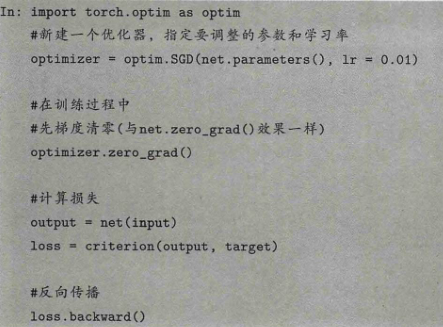Autograd 虽然提供了自动微分,但是如果用 autograd 自行搭建神经网络,也是比较麻烦的;
pytorch 提供了更高级的 API,即 torch.nn 模块,该模块构建于 Autograd 上,其中 nn.Module 是最重要的类,如下
class Module(object): r"""Base class for all neural network modules. Your models should also subclass this class. import torch.nn as nn import torch.nn.functional as F class Model(nn.Module): def __init__(self): super(Model, self).__init__() self.conv1 = nn.Conv2d(1, 20, 5) self.conv2 = nn.Conv2d(20, 20, 5) def forward(self, x): x = F.relu(self.conv1(x)) return F.relu(self.conv2(x)) """ dump_patches = False _version = 1 def __init__(self): torch._C._log_api_usage_once("python.nn_module")def forward(self, *input): raise NotImplementedError def register_buffer(self, name, tensor):def register_parameter(self, name, param):
从中可以看到构建网络的大致步骤
搭建网络流程
在 PyTorch 中搭建神经网络的基本步骤如下:
1. 网络需要继承自 nn.Module
2. 在构造函数中声明可学习参数
// 不需要学习的参数可声明,可不声明
3. 重写 forward 方法,记录前向计算过程
// 只要在 nn.Module 子类中构造了 forward 方法,backward 方法就会基于 Autograd 自动实现
以 LeNet 为例

代码如下
import torch as t import torch.nn as nn import torch.nn.functional as F class Net(nn.Module): ### 必须1:构建网络需要继承 nn.Module def __init__(self): super(Net, self).__init__() ### 必须2:需要学习的参数必须放在 构造函数 中 # 不需要学习的参数可放可不放 ###输入 32x32 单通道 self.conv1 = nn.Conv2d(1, 6, 5) ###卷积层1: 1,输入通道数, 6,输出通道数,5,卷积核 size 5*5 输出 28x28 6通道 ###后面接了2x2的池化,步长 2 输出 14x14 6通道 self.conv2 = nn.Conv2d(6, 16, 5) ###卷积层2: 输出 10x10 16通道 ###后面接了2x2的池化,步长 2 输出 5x5 16通道 ### 全连接层 wx+b self.fc1 = nn.Linear(16*5*5, 120) ###第一层全连接 120 自定义 self.fc2 = nn.Linear(120, 84) ### 第二层 84 自定义 self.fc3 = nn.Linear(84, 10) ### 第三层 10 个分类 def forward(self, x): ### 必须3:构造 forward 前向计算函数 ### 只要在 nn.Module 的子类中定义了 forward,backward 函数就会被自动实现(利用 Autograd) ### 卷积--激活--池化 x = F.max_pool2d(F.relu(self.conv1(x)), (2, 2)) ###池化层1: x = F.max_pool2d(F.relu(self.conv2(x)), 2) print(x.size()[0]) # 1 x = x.view(x.size()[0], -1) # -1 表示自适应,拉伸成 1 维 x = F.relu(self.fc1(x)) # relu(wx+b) x = F.relu(self.fc2(x)) x = self.fc3(x) return x net = Net() print(net) ### 打印可学习参数名称列表 # Net( # (conv1): Conv2d(1, 6, kernel_size=(5, 5), stride=(1, 1)) # (conv2): Conv2d(6, 16, kernel_size=(5, 5), stride=(1, 1)) # (fc1): Linear(in_features=400, out_features=120, bias=True) # (fc2): Linear(in_features=120, out_features=84, bias=True) # (fc3): Linear(in_features=84, out_features=10, bias=True) # )
网络的可学习参数通过 net.parameters() 获取,也可以通过 net.named_parameters 同时获取参数名称和参数值
params = list(net.parameters()) ### 可学习参数 # print(params) print(net.named_parameters) ### 可学习参数及其名称 for name, parameter in net.named_parameters(): print(name, parameter.size())
API
nn 提供了构建神经网络的各种方法
loss function
均方差 nn.MSELoss
用法大致如下,其他函数也类似
predict = net(input) criterion = nn.MSELoss() loss = criterion(predict, label)
交叉熵 nn.CrossEntropyLoss
优化器
torch.optim 中实现了大多数的优化方法,如 SGD,Adam,RMSProp
用法如下

![]()
参考资料: